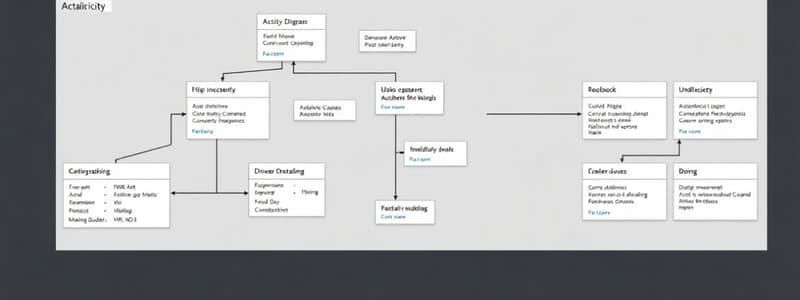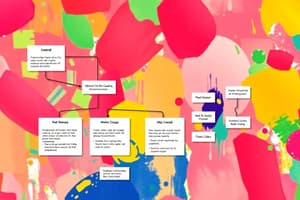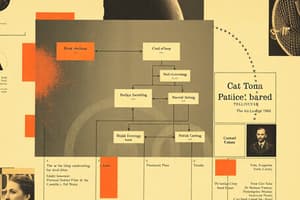Podcast
Questions and Answers
Which of the following best describes the primary purpose of an activity diagram in software modeling?
Which of the following best describes the primary purpose of an activity diagram in software modeling?
- To model the flow of control and dependencies between activities within a system. (correct)
- To define the static structure of classes and their relationships.
- To outline the database schema and data storage mechanisms.
- To depict the user interface layout and design.
In an activity diagram, what is the role of a 'fork node'?
In an activity diagram, what is the role of a 'fork node'?
- To represent a decision point where the flow of activity diverges based on a condition.
- To split a single flow of activity into multiple parallel or concurrent flows. (correct)
- To merge multiple flows of activity into a single flow.
- To indicate the termination point of an activity.
When creating an activity diagram, which of the following is a crucial initial step?
When creating an activity diagram, which of the following is a crucial initial step?
- Writing the code for the core functionalities.
- Designing the user interface layout.
- Defining the database tables.
- Identifying candidate use cases by examining business workflows. (correct)
In the context of activity diagrams, what does a 'merge node' signify?
In the context of activity diagrams, what does a 'merge node' signify?
Which of the following is NOT a typical use of activity diagrams in software development?
Which of the following is NOT a typical use of activity diagrams in software development?
In an activity diagram for modifying a profile photo, a decision node is used to validate the uploaded photo. What happens after the system saves the new photo?
In an activity diagram for modifying a profile photo, a decision node is used to validate the uploaded photo. What happens after the system saves the new photo?
What is the purpose of 'swimlanes' in an activity diagram?
What is the purpose of 'swimlanes' in an activity diagram?
Consider an activity diagram modeling a login use case. What is the likely sequence of events after the 'Start' node?
Consider an activity diagram modeling a login use case. What is the likely sequence of events after the 'Start' node?
In an activity diagram for a train ticket machine, which of the following scenarios best describes the interaction between the traveler and the machine?
In an activity diagram for a train ticket machine, which of the following scenarios best describes the interaction between the traveler and the machine?
When modeling the 'Process Order' activity with an activity diagram, how are the filling and billing activities typically represented to show they occur concurrently?
When modeling the 'Process Order' activity with an activity diagram, how are the filling and billing activities typically represented to show they occur concurrently?
In the 'University Enrollment' activity diagram, what signifies the registrar's decision-making process regarding the completeness of enrollment forms?
In the 'University Enrollment' activity diagram, what signifies the registrar's decision-making process regarding the completeness of enrollment forms?
What is the primary difference between an activity diagram and a swimlane diagram in the context of modeling a business process?
What is the primary difference between an activity diagram and a swimlane diagram in the context of modeling a business process?
During the train ticket purchase activity, if the commuter chooses to pay by credit card, which additional actor becomes involved according to the description?
During the train ticket purchase activity, if the commuter chooses to pay by credit card, which additional actor becomes involved according to the description?
Considering the 'SmartBank' exercise, what would be the most crucial initial activity to depict when creating an activity diagram for a 'withdraw' use case?
Considering the 'SmartBank' exercise, what would be the most crucial initial activity to depict when creating an activity diagram for a 'withdraw' use case?
Which of the following is the MOST important reason for using use case diagrams in the early stages of a project?
Which of the following is the MOST important reason for using use case diagrams in the early stages of a project?
What is the purpose of the “Thank You” screen activity shown by the train ticket vending machine considered from a modeling perspective?
What is the purpose of the “Thank You” screen activity shown by the train ticket vending machine considered from a modeling perspective?
Flashcards
Activity Diagram
Activity Diagram
A diagram used to model workflows by identifying process steps and their conditions.
Activity Diagram Goal
Activity Diagram Goal
Show dependencies and coordination between activities within a system.
Activity Diagram Uses
Activity Diagram Uses
Modelling business processes, understanding concurrent system behavior, and clarifying dynamic system aspects.
Action (Activity Diagram)
Action (Activity Diagram)
Signup and view all the flashcards
Control Flow
Control Flow
Signup and view all the flashcards
Initial Node
Initial Node
Signup and view all the flashcards
End Node
End Node
Signup and view all the flashcards
Activity Diagrams: Swimlane
Activity Diagrams: Swimlane
Signup and view all the flashcards
Swimlane
Swimlane
Signup and view all the flashcards
Use Case
Use Case
Signup and view all the flashcards
Actor
Actor
Signup and view all the flashcards
Actor Interactions
Actor Interactions
Signup and view all the flashcards
Internal workflow
Internal workflow
Signup and view all the flashcards
Use Case Purpose
Use Case Purpose
Signup and view all the flashcards
Activity Diagrams purpose
Activity Diagrams purpose
Signup and view all the flashcards
Study Notes
- UML includes behavior and structure diagrams
- Only use what you need from UML, probably not everything
Activity Diagrams
- Used to model workflows
- Used to identify the steps involved in a process
- Used to identify the conditions that govern the flow of work
- Shows dependencies and coordination between activities within a system
- Shows how events in a use case relate to one another
- Used to describe the parallel, branched and concurrent flow of the system
- Useful when modeling business processes; identifying bottlenecks, inefficiencies and opportunities for improvement
- Helps clarify the system or components behaviour during requirements elicitation
- Requirement analysis clarifies the dynamic aspects of a system's behaviour
Activity Diagram Elements
- Action: A task to be performed
- Control Flow: Execution sequence
- Initial node: Start of the flow
- End node: Terminates the activity
- Decision node: Represents a test condition, the control flow only goes down one path
- Merge node: Used to bring together different decision paths
- Fork node: Splits behavior into a set of parallel or concurrent action flows
- Join node: Brings back together parallel or concurrent action flows
How to create Activity Diagrams
- Identify candidate use cases, through examination of workflows
- Identify pre- and post-conditions (the context) for use cases
- Model workflows between/within use cases
- Model complex workflows in operations on objects
- Model in detail complex activities in a high-level diagram
Activity Diagrams: Swimlane
- Also called functional bands
- The diagram represents the activities being performed
- Swimlane describes who does what in a process or activity performed
Key points summary
- Use case describes high-level functionality
- In Use Cases, understand the actors, use cases and their relations
- Use Cases represent the actor interactions and scenarios
- Use Cases improve communication among stakeholders
- Activity Diagrams represent the internal workflow
- In Activity Diagrams, understand activities, actions and decisions
- Activity Diagrams document step-by-step execution
Studying That Suits You
Use AI to generate personalized quizzes and flashcards to suit your learning preferences.
Related Documents
Description
Explore UML activity diagrams for modeling system workflows and behavior. Learn to identify process steps, conditions, and dependencies. Understand how activity diagrams clarify system dynamics during requirements analysis.



